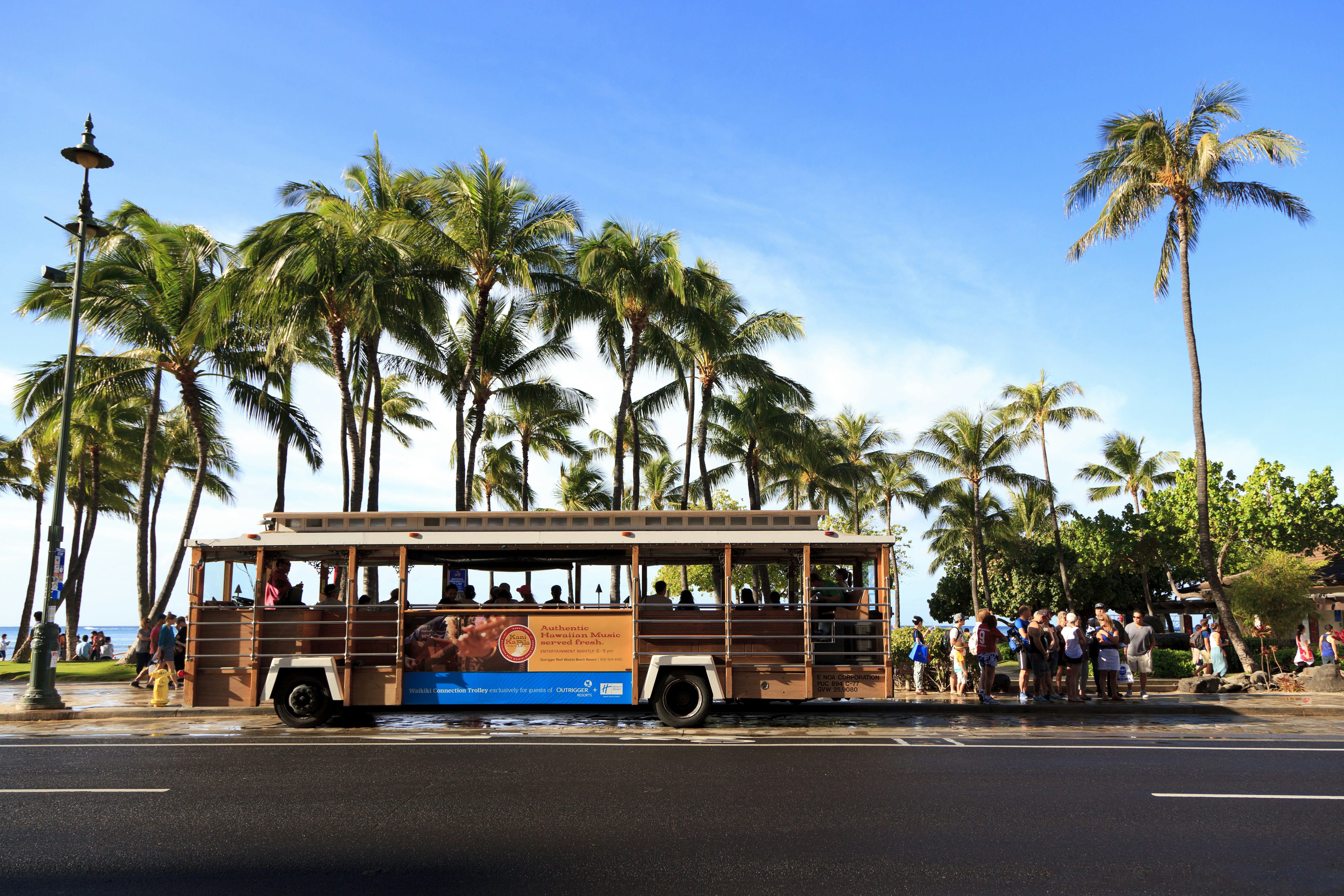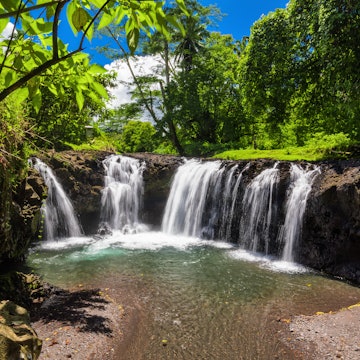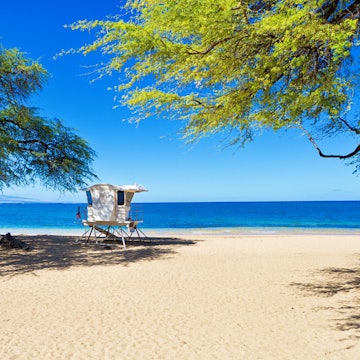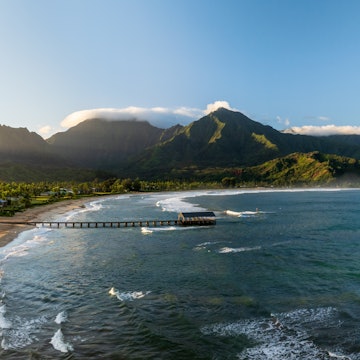

Busy sandy beach at the Hanauma Bay Nature Preserve.
Fringed by beaches and fronted by palms, Honolulu is the most visited destination in Hawaii and also where the majority of Oʻahu residents live, so it should come as no surprise that traffic and congestion are the norm.
The good news is that the airport is only 5 miles from downtown, and there are plenty of ways to get around to avoid the jams. Here's our guide to getting around Honolulu.
Note: From September 2021, Honolulu will require proof of COVID-19 vaccination or a negative COVID test taken within 48 hours in order to enter restaurants, bars, gyms, movie theaters, museums and arcades. For more details, visit the Safe Access Oahu program’s website.

Bus
TheBus, the city’s public transportation system, is a reliable and easy way to get around, and fares are very affordable: journeys start at $2.75 one way. If you are vacationing for several days, consider getting a HOLO pass; you can charge the card with credit and use it to pay for bus rides, and the total daily spend on bus fares is capped at $5.50, even if you go right across the island. You can pick up a pass at ABC stores, Times Supermarket and Foodland locations.
While you can get to beaches and popular sites by bus, one downfall is that buses do not go to the trailheads for Honolulu hikes (a taxi or a rental car is the best option here). The hop-on, hop-off tourist bus known as the Waikiki Trolley is a solid choice for getting to the main tourist attractions.
Car
When you need a break from downtown life, consider renting a car to explore the countryside, regional parks and beaches around Honolulu. Keep in mind though that most hotels in Honolulu charge for parking, and demand for on-street metered parking can outstrip supply on weekdays.
All the big rental firms are represented in Waikiki and at the airport. For cheap deals, search sites like carrentals.com, turo.com, kayak.com and 808 Smart Car Rentals, who offer energy-efficient Smart cars and discounted parking in Waikiki. Ride-sharing companies such as Uber and Lyft also rent out vehicles.

Moped and motorcycle
If you are 16 years or older with a valid driver’s license, you can rent a moped, and explore Honolulu exposed to the balmy sunshine. For motorcycles, you must be 21. Traffic can be a hassle downtown, but on two wheels, it's easy to escape the busyness of Honolulu and go mauka (mountain-side, the local terms for heading inland from the beach).
For a scenic taste of inland riding, take the winding roads to Nu’uanu Pali Lookout, where the heart-stopping views will compel you to stop and reach for your camera. Or drive east down Kalanianaole Highway for views of volcanic cliffs, white-sand beaches and powerful waves.
Taxi
If you are at the airport or a hotel, taxis are easy to find in Honolulu, but you'll need to navigate the sluggish traffic, meaning fares can creep up. TheCab and Charley's Taxi are the biggest local taxi companies. If you're out and about, the cheapest option is to hail a ride via a ride-sharing app such as Lyft, Uber or HoloHolo, Hawaii’s local ride-sharing company.
Tip for taking taxis in Honolulu: If you prefer to stick to traditional taxis, rather than hailing a cab like you would in New York, go to a taxi stand where a concierge will arrange the taxi for you. You'll find them near tourist sights, malls and transport hubs.

Bicycle
Cycling can be a good option for sightseeing. Biki, Honolulu’s bike-sharing program, has 1300 bikes and more than 130 bike stands dotted around Honolulu; affordable fares start at $4 and non-residents can rent bikes for up to five hours at a time. Purchase a pass at the kiosk or download the Biki app.
Popular routes include Ala Moana Regional Park, the tracks around Magic Island Lagoon, the South King Street protected bike lane, trails by the Ala Wai Canal and the 4.3-mile Waikiki Loop. Keep in mind that Hawaii has a state law requiring cyclists under 16 to wear helmets. Also, be aware of traffic at all times; Honolulu is a busy and crowded city and drivers don't always give cyclists room to maneuver.
Walk
More good news: Honolulu is eminently walkable. Sidewalks are well maintained, and many of the capital city’s historic treasures – the Aloha Tower, ʻIolani Palace, the seafront statue of King Kamehameha and the Hawaiian Mission Houses, to name just a few – are within walking distance of each other.
Start walking in Kaka’ako, which was once a gritty industrial district back in the 1800s, but it's now a hub of Honolulu activity. Known for its street murals and ample stock of pubs and local boutiques, it’s not only great for keeping busy, it’s also perfect for people watching.
Equally walkable is the nearby Chinatown District, a cultural gem, full of traditional Chinese markets, herbalists, bakeries and artisanal shops. The Hawaiʻi Heritage Center offers 2-hour walking tours that focus on the food, culture and heritage of the district, or take a self-guided tour and discover at your own pace.
Waikiki is walkable, too. Here you’ll find upscale shops such as Chanel, Coach and Gucci, more interesting local boutiques and lots of fancy resorts, plus Honolulu's most famous stretch of sand. Wind up your walk with an amble around Honolulu Zoo and the impressive Waikiki Aquarium.

Accessible transportation in Honolulu
For travelers with disabilities, rental vans with wheelchair access can be found through companies like Soderholm Mobility and Wheelers Accessible Van Rentals. Taxi and shuttle companies with accessible vehicles include TheCAB, Charley’s Taxi and Flash Shuttle Services. When traveling on TheBus, drivers will help you access the ramp or lift.
Newer hotels have elevators and wheelchair-accessible rooms (just be sure to book well ahead of time), but getting around town can be a mixed bag. Streets and sidewalks tend to be accessible with ramps, and all museums and public buildings are ADA compliant, but there are many areas where it gets tricky for the mobility impaired.
Visit the website of the Disability and Communication Access Board for more tips on traveling around Hawaii for those with disabilities; there's also useful information available from Lonely Planet. For information on airport accessibility, the Department of Transportation website is handy. Sign language interpreters are available through Hawai’i Interpreting Services and Isle Interpret.
Ready to explore more? You can find all-terrain wheelchairs at Ala Moana Regional Park, Fort DeRussy Beach, Sans Souci Beach, Hanauma Bay Nature Preserve, Kailua Beach Park, Kualoa Regional Park and Pokaʻi Bay Beach Park. Contact the Department of Parks and Recreation for more details.
You may also like:
20 free things to do in Honolulu
Hidden Honolulu: step away from the crowds in Hawaii's capital
The best time to visit Honolulu
















